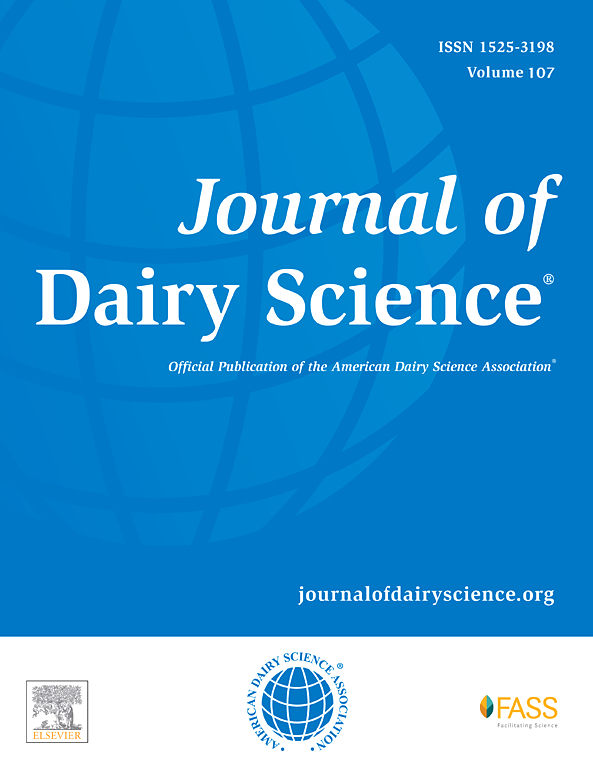Quantification and metabolic variations of mycotoxins in raw milk: Implications for dairy cow health and human safety
IF 3.7
1区 农林科学
Q1 AGRICULTURE, DAIRY & ANIMAL SCIENCE
引用次数: 0
Abstract
This study established a method using ultra-performance liquid chromatography-tandem MS for the quantitative analysis of 9 harmful mycotoxins: zearalenone (ZEN), α-zearalanol, HT-2 toxin, T-2 toxin, ochratoxin A, fumonisin B1, deoxynivalenol, aflatoxin M1, and aflatoxin B1 in raw milk. The method exhibited good linearity, sensitivity, accuracy, and precision, making it suitable for trace analysis of these toxins in raw milk. We applied this method to analyze 200 raw milk samples from Heilongjiang Province, China, and found that they contained multiple mycotoxins, with a relatively high concentration of ZEN. To further explore the metabolism of these mycotoxins in dairy cows, we conducted a metabolic study on 12 lactating dairy cows. The results showed significant metabolic changes among the 9 mycotoxins, with ZEN demonstrating notably higher metabolic conversion rates compared with other mycotoxins in the transitions from feed to serum, from feed to milk, and from feed to feces. These findings provide new insights into the safety of raw milk and emphasize the importance of strict monitoring and regulation of these toxins in dairy products to protect human health. Simultaneously, we believe that future research should delve deeper into the metabolism of mycotoxins in dairy cows, which is crucial for ensuring public health safety.
原料奶中真菌毒素的定量和代谢变化:对奶牛健康和人类安全的影响。
本研究建立了用超高效液相色谱串联质谱法定量分析原料奶中玉米赤霉烯酮(ZEN)、α-玉米赤霉烯醇(α-ZEA)、HT-2毒素(HT-2)、T-2毒素(T-2)、赭曲霉毒素a (OTA)、伏马菌素B1 (FB1)、脱氧雪腐菌醇(DON)、黄曲霉毒素M1 (AFM1)和黄曲霉毒素B1 (AFB1) 9种有害真菌毒素的方法。该方法具有良好的线性、灵敏度、准确度和精密度,适用于原料奶中这些毒素的痕量分析。我们应用该方法分析了来自中国黑龙江省的200份原料奶样品,发现它们含有多种真菌毒素,其中ZEN浓度较高。为了进一步了解这些真菌毒素在奶牛体内的代谢情况,我们对12头泌乳奶牛进行了代谢研究。结果表明,9种真菌毒素在饲料到血清、饲料到牛奶、饲料到粪便的转化过程中代谢转化率显著高于其他真菌毒素。这些发现为原料奶的安全性提供了新的见解,并强调了严格监测和监管乳制品中这些毒素对保护人类健康的重要性。同时,我们认为未来的研究应该更深入地研究霉菌毒素在奶牛体内的代谢,这对确保公众健康安全至关重要。
本文章由计算机程序翻译,如有差异,请以英文原文为准。
求助全文
约1分钟内获得全文
求助全文
来源期刊

Journal of Dairy Science
农林科学-奶制品与动物科学
CiteScore
7.90
自引率
17.10%
发文量
784
审稿时长
4.2 months
期刊介绍:
The official journal of the American Dairy Science Association®, Journal of Dairy Science® (JDS) is the leading peer-reviewed general dairy research journal in the world. JDS readers represent education, industry, and government agencies in more than 70 countries with interests in biochemistry, breeding, economics, engineering, environment, food science, genetics, microbiology, nutrition, pathology, physiology, processing, public health, quality assurance, and sanitation.
 求助内容:
求助内容: 应助结果提醒方式:
应助结果提醒方式:


